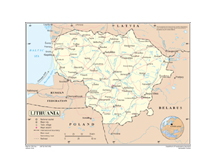|
How to use the Gazetteer
All entries in the gazetteer are in Lithuanian alphabetical order, but for this database has been converted into English alphabetical order. Additionally, an entry of two words is alphabetized as if it were one word, e.g. Naujoji Rūda is followed by Naujoji Ūta and Naujoji Vilnia. The Lithuanian names of that type are cross-referenced, e.g. Baltoji Ančia and Ančia, Baltoji and the comma breaks the sequence of the name. Alternative names, Lithuanian and foreign, are likewise cross-referenced. All names are followed by topographic descriptions, such as mst. In the entries of Lithuanian names these are preceded by a number (1, 2, 3, 3a, 3b, 44a, 34b, 4) indicating the stress pattern. Position is shown by reference to the "squares" of the map; these are designated by numbers and letters. The diagonal and the dash are used to indicate the position of a river or a lake in more than one square, e.g. Neris J/L8-M/O/R/S9-P10, Avilys O4/5.
The following is a guide to the abbreviations used in this database. To learn additional information about each of the listings, click on the listing of interest to open a new window and display the associated information.
Santrumpos (Abbreviations)
Žemėlapyje ir vardyne vartojamos šios santrumjos
(The following abbreviations are used in the map and the Gazetteer):
| A. - Aukštoji (Upper) | Juod. - Juodasis, Juodoji, Juodieji (Black) | perk. - perkasas (canal) |
| ag. - angliškai (English) | k. - kaimas (village) | pilk. - piliakalnis (tumulus) |
| aps. mst.- apskrities miestas (district city) | Kan., kan. - Kanal, kanał (canal) | S. - Senasis, Senoji, Senieji (Old), See |
| B. - Bach, Berg | Kl. - Klein (Little) | sen. - senovėje (ancient) |
| Balt. - Baltasis, Baltoji, Baltieji (White) | kln. - kalnas (mountain) | sov. - sovietinis (Soviet) |
| bžk. - bažnytkaimis (church village) | lat. - latviškai (Lettish) | st. - žr. (see) gst. |
| D. - Didysis (Great) | lenk. - lenkiškai (Polish) | trm. - tarmiškai (dialectal) |
| dv. - dvaras (estate) | liet. - lietuviškai (Lithuanian) | up. - upė (river) |
| ez. - ezers (lake) | m. - moteriškos giminės (feminine) | v. - vyriškos giminės (masculine) |
| ež. – ežeras (lake) | M. - Mažasis (Little) | vd. - vardininkas (nominative) |
| Gr. - Gross | Mł. - Mała | vok. - vokiškai (German) |
| gst. - geležinkelio stotis (railroad station) | mst. - miestas (city) | vsd. - vienasėdis (farm) |
| gud. - gudiškai (White Russian) | mstl. - miestelis (town) | Wlk. - Wielka (Great) |
| įl. - įlanka (gulf) | N. - Naujasis, Nowa (New) | Žem. - Žemoji (Lower) |
| Jez. - Jezioro (lake) | pel. - pelkė (marsh) | žr. - žiūrėk (see) |
Pronunciation
The Lithuanian spelling is almost phonetic. The pronuciation key is
given below.
Vowels |
Consonants The consonant letters p, b, t, d, f, v, h, k, l, m, n, r, z have their normal English values. The rest are pronounced: c – as in 'tsar' č – as in 'church' g – as in 'get' j – as in 'yes' s – as in 'see' š – as in 'sharp' ž – as in 'measure' |
LITHUANIAN ALPHABET
a, ą, b, c, č, d, e, ę, ė, f, g, h, i, į, y, j, k, l, m, n, o, p, r, s, š, t, u, ų, ū, v, z, ž. The letters ą, į and y, ų, and ū are alphabetized without difference as plain a, i, u. Polish ż is treated like Lithuanian ž, and w follows v. For this database, the information is alphabetized according to English rules.
Connected successfully
A B C D E F G H I J K L M N O P Q R S T U V W X Y Z Original View
(Total Number of Records in Database: 268)
If you have a database or information that you would like to put into our database, that pertains to Lithuanian genealogy, please contact us at webmaster@lithuaniangenealogy.org
 Lietuvos
Zemelapis - 1939
Lietuvos
Zemelapis - 1939